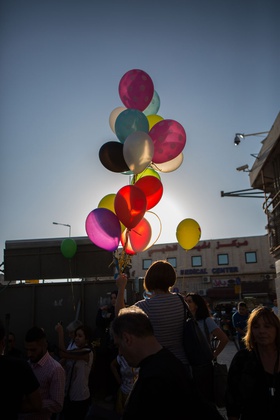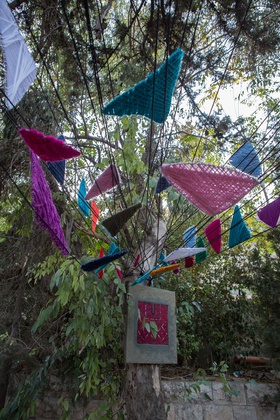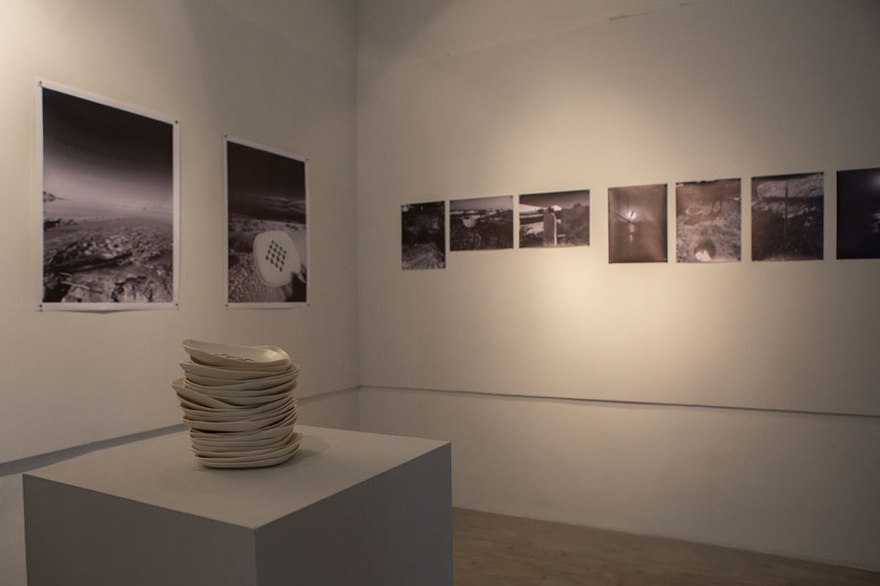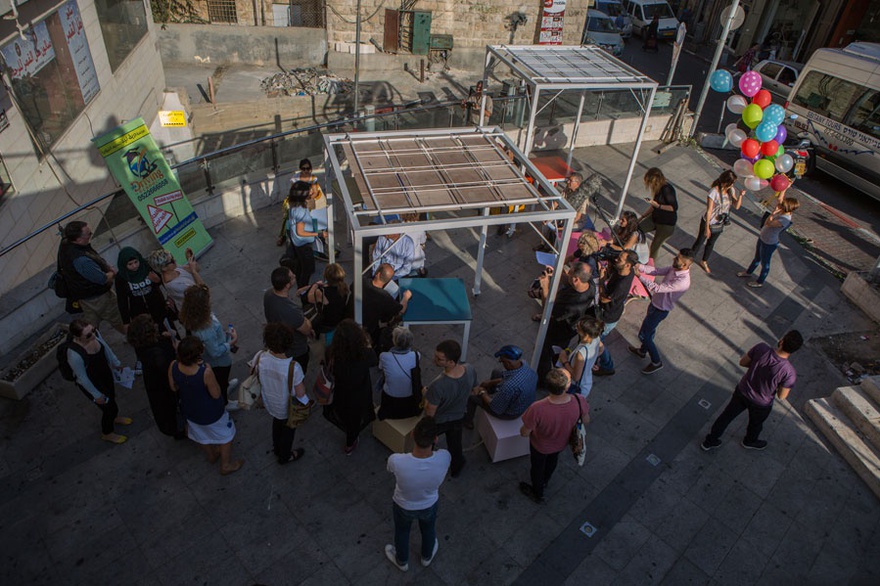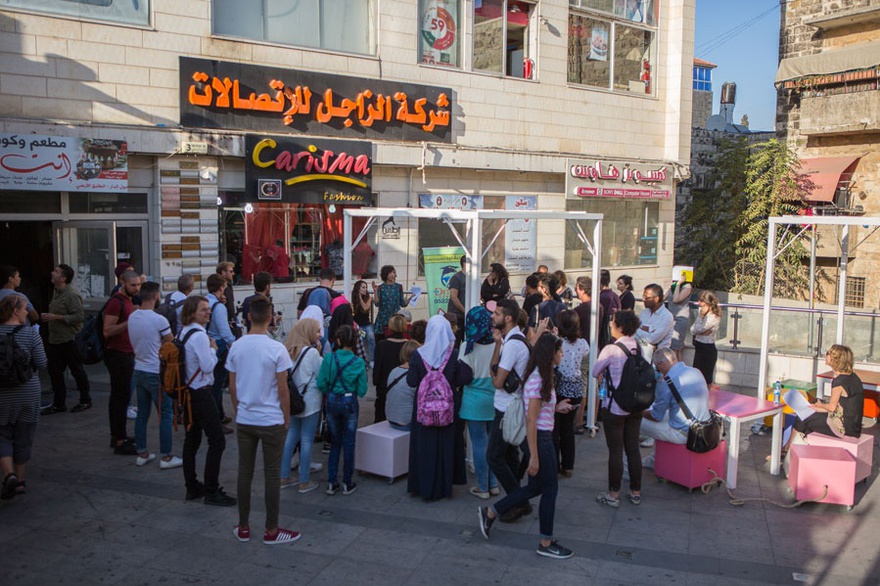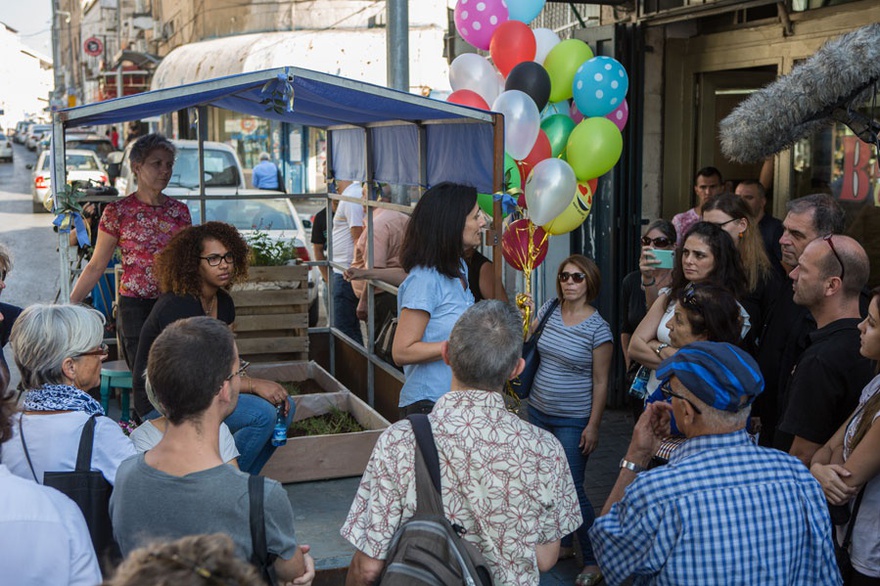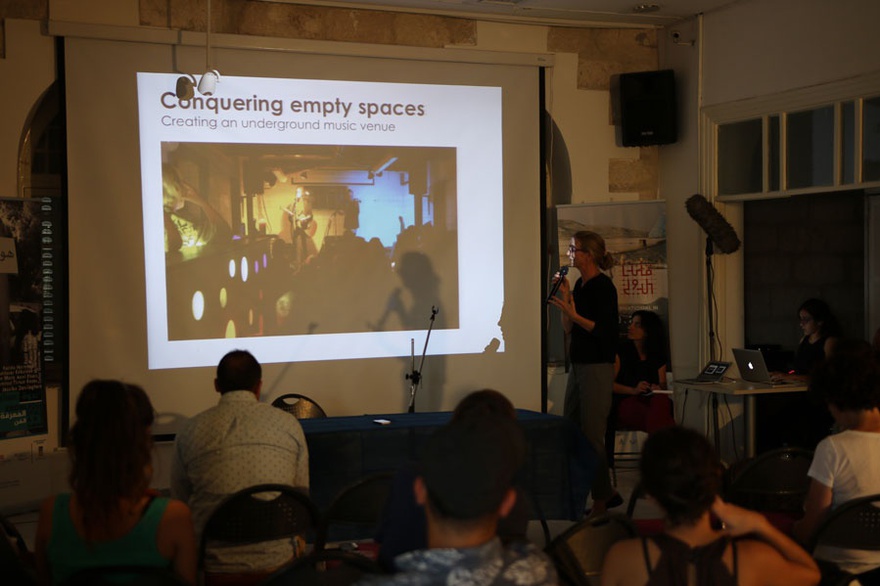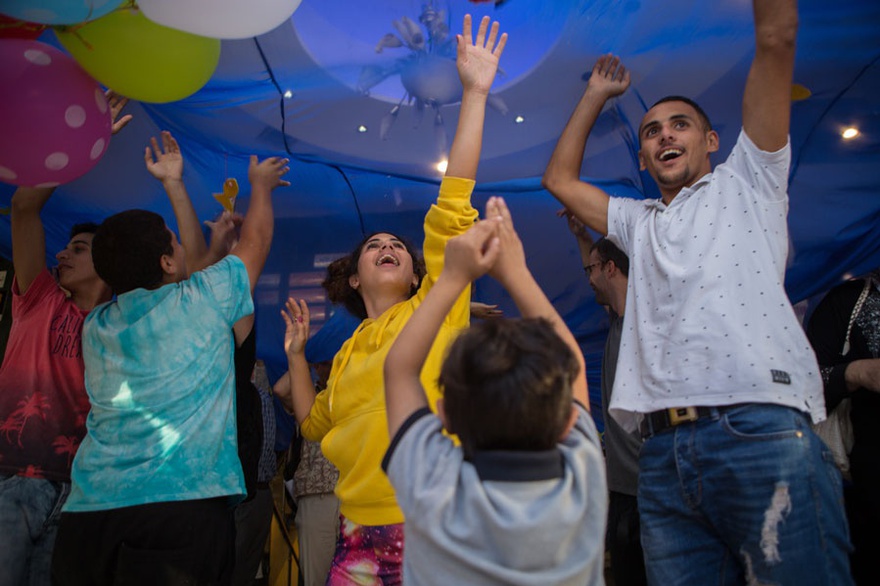Publications
Future Imperfect
Alia Rayyan: Recounting the Past, Present and Future
Jerusalem has never been an easy address but, since the increased tensions and violence of 2014, life has become more difficult. Showing art in these surroundings has its very own rules and framework, especially for a Palestinian organization. Since the building of the wall, Jerusalem has been isolated from its natural hinterland and deprived of economic and cultural exchange with Palestinians from the West Bank. Most Palestinian organizations located in Jerusalem have shifted their offices to Ramallah to allow greater access to the public. Though East Jerusalem has been given political priority and greater importance within the Palestinian national narrative, the reality in the field is quite different. Palestinian cultural and economic life remains concentrated in Ramallah, while living in Jerusalem is like living in a satellite city, cut off from development and exposure.
How does an art institution situated in such circumstances deal with its mission and programme? What is the role of art in contested cities like Jerusalem? In this essay, I try to draw a picture of my experience as the Executive Director of the Jerusalem-based art organization Palestinian Art Court – Al Hoash, opening up the white cube to the city, trying to find new formats of critical interaction within a suppressed society. This essay is rather a personal theoretical resume of a two-year experience than an overall analysis of the general development of art institutions in Palestine. Nevertheless, it can be taken as a challenge, questioning current approaches in Palestinian art institutions, without having any claim to be complete.
The question of whether art should respond to social responsibility is not new and has previously been tackled by many prominent artists and philosophers. In the case of Al Hoash, it has always been important to remain a part of the community, as it was founded with the aim of preserving and promoting cultural heritage and art. The Palestinian Art Court – Al Hoash was established in 2004 by a group of art enthusiasts and art collectors. Their goal was to lay the foundation for a future Palestinian art museum in Jerusalem with the mission of preserving and promoting Palestinian art and cultural heritage. Creating a Palestinian art museum in Jerusalem is not an easy task, as its creation depends entirely on external forces and political developments. Nevertheless, over the years, the Palestinian Art Court – Al Hoash has been and is able to establish itself as an important art organization in Jerusalem and has organized a large number of art exhibitions of Palestinian and international artists, published several works on Palestinian art and practitioners, and provided educational programmes with workshops for youths, women and children.
Ten years later, the political situation in Palestine has not improved and Palestinians are still far away from full recognition, independence and equality. Witnessing the downward spiral of basic living conditions and the ongoing fragmentation of Palestinian social realities – such as the divisions between different ID holders with limited access to Jerusalem, the policy of denying permits to build or upgrade housing units, there being no investment in Palestinian-inhabited areas in Jerusalem, and closures and roadblocks to hinder mobility between Palestinian villages and cities – it became clear that Al Hoash's mission to preserve cultural heritage and art needed a re-evaluation. What does it mean to preserve cultural heritage in a place with such harsh political realities? A place where the land is divided into zones of A (under full Palestinian control, 18 per cent of the West Bank), Area B (under Palestinian Authority civil control and Israeli military supervision, 22 per cent) and Area C (under full Israeli control, 60 per cent). Is it sufficient to produce intellectual material and show art works in a ''white cube gallery'' in order to preserve knowledge and heritage for future generations to enable them to remember their identity and origin? Or should there be a broader interpretation of that mission in light of the ongoing political and social deterioration? What is the task of an organization in such a context, when surrounded by people in despair who are suffering from living under occupation?
In view of the fact that Al Hoash is located in Jerusalem, which is very clearly a conflict zone, it was not an option for me as the Executive Director to work within the framework of art existing for its own sake. At the same time, I acknowledged the need for the space to involve a younger generation of artists and art students whose topics of interest would be covered. The aim was to create a balance between these needs without losing the original focus of Al Hoash to preserve art and cultural heritage. After some investigation and evaluation of the situation in 2014, we decided to concentrate our programme and sharpen the profile of the organization. Instead of trying to fulfil many needs, we preferred to choose priorities with the aim of establishing a distinction between the different programmes. To do this we decided to open up the space for more interaction and create a meeting place for visual culture, critical thinking and innovative formats. We turned away from being simply a service point for people who are interested in art and attempted to become a centre that engages the public in a creative and participatory way.
The level of scepticism, fear and reluctance on the part of the community members and social associations towards change or any attempt to challenge the current system and situation is very high in Jerusalem. People tend to restrict themselves to the private sphere, which seems to be the only space where one can be free and secure. But it has also risen after the years of increased conservatism and religious ethical rules that seem to have been put forward by much of Palestinian society as the solution to preserving the identity and resisting the current status quo. What was needed was a spark, to revive the community and support attempts to liberate the Palestinian public in Jerusalem from its current passivity.
The role of Palestinian art in society
When comparing the situation of Palestinian society with the Palestinian art scene, the gap of understanding and missing interaction becomes apparent. Our vibrant internationally connected art world can look back and witness the development of its excellence and art canon. Today in Palestine we have a number of art organizations, foundations, commercial galleries and educational entities in the field of visual art. The centre of cultural interaction and exchange, nevertheless, has been transferred to Ramallah. Jerusalem has become a satellite city - not only culturally but also economically and politically. But the improved situation of the Palestinian art scene did not influence its relationship with society; art has still not been recognized as having a value in society. Instead, we see that artists tend to lose their connection with their communities and art centres are perceived as exclusive spaces for select elites.
Socially engaged art has always been part of the Palestinian artists' scope, with a peak in the late 80s until the end of the 90s when, during the First Intifada, solidarity and common interests created a more unified society, less differentiated by origin or profession. With the signing of the Oslo agreement in 1994 and the relative increase of freedom in cities like Gaza or Ramallah, art was no longer forbidden by the occupying power as described by the first generation of Palestinian artists in the 80s and, in fact, became part of the movement to develop and establish infrastructure, education and civil rights. First, art organizations were established and inspiring art projects took place such as the Khalil Sakakini Center in Ramallah in 1996 or the Al Ma'mal Foundation in Jerusalem in 1997. Since then, society has been faced with many disillusions and has been greatly disappointed by the Palestinian government, the failed peace negotiations, and the growing domination of neo-capitalistic structures and regulations.[1] The problems became complex and artists felt deprived of the ability to make any change. Instead, they turned to the international scene for their work, reflecting upon the problems at home, in the hope of recognition and success.[2] Artists turned their work to the micro level, and their personal observations, questions of the individual's rights, the issue of recognition and an urge for more freedom of expression are more dominant themes. A new generation of artists like Jumana Abboud, Raeda Saadeh or Larissa Sansour can be seen as an example.
In October 2014, we started a discussion amongst artists, curators and art organizations, who were facing the growing gap between artists and society and the old dilemma on the division between socially engaged art and art for art's sake. The frustration over the fact that socially engaged art did not help to make a change was common. This reaction is a reflection of a worldwide phenomenon in our globalized world, but frustration cannot be the only answer. Al Hoash has made it a priority to find alternative formats for socially committed art and public space engagement to support social change, which in turn attract both artists and local communities. It was also important for us to build up a programme that serves artistic excellence in combination with the need to revitalize the community and support their identity. We found creative examples worldwide. In 2013 we were introduced to alternative formats beyond classical structures and the understanding of outreach projects. Mahatat – Contemporary art (Cairo) or the experience of Råderum (Denmark) inspired us to create a new vision for our field of work. Both organizations have been working for several years in creative place-making and have achieved some impressive results in engaging with their particular community. They work locally with marginalized social groups in their cities and create participatory programmes that tackle issues like social exclusion, urban development and participatory citizenship by initiating urban furniture courses, place-making concepts, performative and participatory street activities. We introduced these examples to local participants (the community centres and the artists) to allow them, and us, to understand the positive long-term effects of such changes in programming.
The specifics of Jerusalem: the definition of public space in an occupied city
In Jerusalem, permits are needed for any gathering or activity in public spaces and can only be issued by the Israeli municipality. Any gathering of people can be easily qualified as political activity and requests have only minimal chances of being accepted. The lack of public infrastructure and spaces in East Jerusalem – in comparison to West Jerusalem – complicate any chance of designing public engagement beyond the classical form of street festivals. Defining public space under these circumstances has its very own rules. We started to re-define private space and reached out to the owners, trying to convince them to open up their spaces for the public, at least temporarily. We realized one positive example by opening up the historical Husary market hall in the Old City of Jerusalem, which is owned by a private Palestinian interest group and had been closed to the public since 1967. Another current example is the terrace of the Dar mall on Salah Eddin Street. The mall is a landmark in Jerusalem, as its history tells a lot about the infrastructural development and Palestinian narrative of the last 60 years. Planned originally as a hotel, the building has never been finalized as the process was interrupted by the aftermaths of the war in 1967 and the occupation of Jerusalem. Its skeleton has dominated the skyline of East Jerusalem for the last 50 years – an unusual memorial for the standstill of the development of Palestinian independency. It took the Palestinian owner until 2005 to get a permit to renovate the building and open a small shopping mall, which soon lost its appeal due to vandalism and economic crises, which left its foot prints in the place. Nevertheless, its location is central and people pass by it as part of their daily routine. The terrace was a perfect semi-public space, which could benefit from some upgrades through our urban interventions. Besides finding partners in the private sector to reclaim public space, we needed to define short term action points, interfering in the normal public space like the streets and entrances of public buildings such as schools or hospices. Our programming had to be designed accordingly. Short term urban gardening interventions on roof tops and in community centres or flash mob performances in the street, based on the unexpected spectacle, included artists and community members and changed the atmosphere and perspective on the use of common space for a moment.
Often, we faced challenges, due to the already mentioned existing fear and scepticism within society, where people often prefer to retain the status quo than challenge the current situation. This observation concurs with the theories of Frantz Fanon, who demonstrated how colonialism affects the bodies of suppressed peoples.[3] The repressive circumstances of colonialism influence each individual body and teach people to stay within the limited borders ascribed to them; the colonized body learns not to cross the borders imposed by the system.[4] As a result, Jerusalemites tend to restrict themselves to their private spaces, which seem to be the only places where they can feel free and secure. Social scientist Michael Warner argues that the condition of Palestinians as a minority in Israeli-occupied East Jerusalem has created a sense of political depressiveness. At this stage, activism is naturally blocked and 'a disintegration of politics results in isolation, frustration, anomie and forgetfulness.'[5]
Translating this thought to the idea of place-making in Jerusalem, we tried to combine the ephemeral action-driven participatory art approach with long term engagements. To this end we created pilot projects that invited artists and community members to engage with each other and with public space, and repeated this activity over a longer duration. This process-oriented work also included the need to allow these projects to unfold away from the control mechanisms of the institution and the curator. Positive experiences that strengthened creative capacities needed to go hand in hand with artistic interventions, initiated by artists and practitioners. Urban interventions in the tradition of place-making methods and guerrilla actions seemed to be a promising form of supporting the process – for the institution as well as for the participating artists and community members. One example is the globally known PARKing day action, which we carried out in the immediate neighbourhood of Al Hoash. Parking places with meters are transformed into little gardens, playgrounds or sitting areas for a time. What is originally meant to be participatory citizenship and changing the common structure of the street, is also dominated by the needs of car drivers as in cities like San Francisco, Barcelona or Seattle. The PARKing day allowed us to be active in the street, without fearing legal persecution. By paying the parking meters, the action became legal.
Reclaiming the city at large became the next logical step within the new approach. As mentioned before, public spaces in East Jerusalem are not easily accessible for planned interventions, as they can be observed by the Israeli army or police and, lately, they have been transferred into a location of normative void, where civilians and/or the military can commit acts of violence under the umbrella of self-defence. A precondition for transferring practices of place-making to Palestinian Jerusalem – and a major difference to its counterparts in Europe – is the decision not to tackle public spaces that are defined by the state, but to discover, together with artists and the community, new positions for public space in Jerusalem that can be accessible for public use and engagement. Due to the fact that most Palestinians do not feel safe in public space, it was necessary to come up with alternative ideas.
One alternative idea was to create new spaces, which we could define and open for the public. Being safe and inviting were the main elements that needed to be taken into consideration. Similar to location scouting, the team at Al Hoash searched for spaces and discussed with community members where these new creations could be. Scrolling through community centres, shops, hotels, or forgotten former public buildings were the main activities in the preparation phase. During this search process, we invited art practitioners such as the urban guerrilla interventionists group Bureau Detours from Copenhagen and an urban artist from Ireland to work together with Palestinian artists to build a temporary collective to visit the selected semi-public spaces and jointly create art interventions. This gathering was realized under the project RE/viewing Jerusalem, an ongoing long-term approach to discover the city from a different angle. The spaces are transformed into new public art stations, building a walk through the city through which one can discover unknown places and people. The international artists were invited for a residency in a flat situated in the residential area of the Old City. Over the duration of three weeks the collective took over the space of Al Hoash and discovered the surrounding area, meeting its community members and discussing possible topics for the selected stations. Ownership of the process was given to the artists as part of the concept to dissolve the hierarchy of the classical curatorial and institutional set up. After discussions with community members and the daily routine of passing and observing the life between Old City and Zahra Street, the artists chose the main themes of silence and repose to inspire their work, as a natural reaction to the turmoil that confronted them in the city.
The chosen locations were situated between al Zahra Street and the Elsofimus Market in the Old City and variegated between urban furniture, a pause in a forgotten dead-end street next to the garden, an art intervention in the community centre Abna Al Quds, or a music performance in a historic building of the former vegetable market in the bazaar. Each had in common the instruction to refrain from using the selected space only as an exotic background for their art work or performance, but to find ways to integrate with and react to the space and its community. Every station had its very particular set up. The participants of the tour were led from one station to the other and given an introduction to the space, its background, and its connection to the art intervention. The walk combined methods of alternative tourism, as used in other cities like Berlin, Barcelona or London, to introduce the life of certain undiscovered districts through a participatory art intervention.
Conclusion
After two years of this new style of engagement, we look back and feel confident at having chosen the right direction to answer the questions stated at the beginning of this essay. Preserving cultural heritage and strengthening identity needs a wider interpretation in conflict zones. Art cannot alleviate the impact of a conflict, or create a comfort zone, but it can nevertheless stimulate a space for creative and imaginative interaction, so as to see beyond the current restrictions and oppression. Ensuring respect for people's needs and handling the programmes with professionals are essential steps in enabling the project to grow. Starting with one place in the neighbourhood and letting the project gradually develop – parallel to the people's will to increase their engagement with the public space and art – has proven to be the right choice.
After the first two years of working with this approach, a small but engaged group of young artists have adopted the idea and continue to experiment with formats of participatory art practice. Two community centres opened up their doors for our interventions and urban gardening ideas and a lively exchange between their community members and artists (local and international) has to grow. After long time of negotiation, we were able to convince one of the private sector companies to support our efforts and opening up their mall space for urban intervention and community activities. The idea to start on a smaller scale to let people experience the concept of urban intervention and participatory place-making art seems have been the right choice. In October 2016, we invited a number of initiatives and groups from Europe and the Arab world, to gather in Ramallah and Jerusalem, exchanging experiences and ideas. It feels much more like the beginning of a movement than a programme of a certain cultural institution. And though every country has its very specific circumstances and constraints, we have realized that we all share a common denominator: the interest to work directly with the community, to re-define the role of art in society and not to challenge the dominant (occupying) powers. A first giant step has been taken and we are excited to carry on this journey, despite the constant state of political disillusionment. Surely, more research and analysis needs to be done on the ground to understand the interrelationships between artists, the community and social change, so as to enable the movement to grow.
Alia Rayyan is the director of Al-Hoash Gallery – The Palestinian Art Court, Jerusalem, since September 2013, where she has created a new focus on social art engagement with urban interventions to confront the specific circumstances in public spaces for Palestinians in the city. From 2003–2005, she worked as the senior editor for the art magazine Bidoun. Previously, Rayyan worked in Berlin, Beirut, Amman and Ramallah for organizations including Berliner Festspiele, House of World Cultures, UNESCO, Heinrich Boell Foundation and GIZ. Her interests shifted to image, language and identity when she moved to Palestine in 2007. Rayyan holds an MA in international politics, with a focus on the Middle East, Sociology and History of Art, from the University of Hamburg and School of Oriental and African Studies (SOAS), London. Rayyan is an independent curator and a PhD candidate at the Leuphana University Graduate School for Cultures of Critique, Forms, Media and Effects.
[1] Lisa Taraki, 'Enclave micropolis: The paradoxical case of Ramallah/al Bireh,' in Journal of Palestine Studies 37.4 (2008): p. 11.
[2] Adila Laidi Hanieh, 'Grievability as political claim making: the 100 Shaheed - 100 lives exhibition,' in Arab Studies Journal 22.1 (2014): p. 50.
[3] Jens Kastner, 'Koloniale Klassifikationen: zur Genese postkolonialer Sozialtheorie im kolonialen Algerien bei Frantz Fanon und Pierre Bourdieu,' in eds. Daniel Suber, et al., Pierre Bourdieu und die Kulturwissenschaften: zur Aktualität eines undisziplinierten Denkens (Konstanz: UVK Verlagsgesellschaft, 2011), p. 296.
[4] Ibid.
[5] Michael Warner, 'Publics and Counterpublics,' in Quarterly Journal of Speech 88.4 (2002): p. 415.

